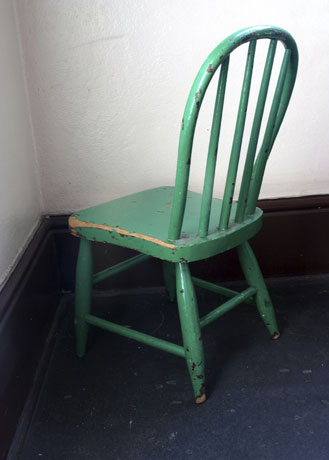 Who hasn’t coped with a difficult child? Even the most serene kids occasionally exhibit what we like to call “behavior.” Maybe the child refuses to cooperate, tosses toys around or simply acts sassy.
Who hasn’t coped with a difficult child? Even the most serene kids occasionally exhibit what we like to call “behavior.” Maybe the child refuses to cooperate, tosses toys around or simply acts sassy.
Which leaves parents with that familiar dilemma: how to deal?
With spanking pretty much off the table, time-outs have surfaced as the go-to discipline tool. But just how effective are they?
Soon after Julia LaRose’s son was born, daughter Sylvia, now 5, began acting out. Time-outs, says LaRose, who lives in Maple Leaf, proved useless. “There were a few instances where Sylvia would get really violent,” she remembers.
LaRose tried scolding. She tried taking toys away. Sylvia would just find other, more inventive ways to misbehave. Then things escalated. “At one point, she was spitting and kicking, and I couldn’t go near her,” says LaRose. “I couldn’t keep her in a time-out. It was pointless to even try.”
Time-outs — which means separating a child for a specific period of time (typically in a chair or another room) — sound innocuous enough. But when parents use them as a form of punishment, some experts claim they are ineffective and often harmful.
“Punishment might work in the short term, but it does not work to extinguish behaviors in the long run,” says Melissa Benaroya, co-owner of Grow Parenting, a business based in the Puget Sound area that specializes in parent coaching and consulting. “Punishment is just a way of controlling children; they ultimately end up rebelling or disrespecting their parents because the kids were treated in a really disrespectful way.”
Punishment or discipline?
Not every time-out is a bad thing. Sports teams call time-outs to stop the action in a game and confer with a coach. And calling a halt to adverse behavior can be a useful parenting practice. “There is a gray area between discipline and punishment,” says Benaroya. “Sometimes this idea of time-out can lie on either side, depending on how you choose to use it in your parenting.”
When time-outs are used as punishment, parents often think their child needs a prescribed interval — and maybe just a morsel of unhappiness — to learn her lesson. But that doesn’t always work. “Children sit there thinking, ‘My parent doesn’t love me’ or ‘I hate my parent’ or ‘How can I get away with this next time? ’” says Benaroya. “They aren’t thinking about how they shouldn’t have done what they did or how they could have done things differently.”
While this may stop bad behavior in the short term, it doesn’t offer much in the way of guidance. “I think we want children to learn from these situations and figure out ways to navigate them better the next time,” says Benaroya. “Sitting in a corner getting frustrated and angry doesn’t get you anywhere. There’s no learning that takes place.”
Taking a time-in
In the heat of the moment, what other options do parents have? Strong emotions often need some time and space to simmer down, and children need help processing emotions. Dr. Laura Markham, the author of "Peaceful Parent, Happy Kids: How to Stop Yelling and Start Connecting," says that when your child is becoming emotionally overwrought, instead of sending him off alone to his room for a time-out, you can take a “time-in” break with him to help him calm down.
“This signals to your child that you understand she’s got some big emotions going on and you’re right there with her,” she says. “If she’s just a bit wound-up and wants to snuggle or even read a book, fine. If she needs to process some big emotions by having a meltdown, you’re there to help. Just let her know you’re there and she’s safe.”
Dr. Markham says if your child is already in the throes of a tantrum or is emotionally out of control, don’t try to talk or reason with him. “Just stay nearby so you don’t trigger his abandonment panic, and stay calm,” she says. “Don’t give in to whatever caused the meltdown, but offer your total loving attention.”
Positive discipline
Benaroya suggests using a positive discipline approach. “As kids get older, they should choose a place in the home where they feel secure and supported,” she says. “Parents can suggest that the child go there when the child is too upset to process a difficult situation.” This time alone should be followed up by a meaningful conversation with a parent, she says.
Such positive time-outs can hone children’s self-soothing skills. Benaroya says it gives kids the space and ability to experience their feelings — then calm down so they can talk about what happened. “Talking afterwards is key to helping your child understand what they were feeling and how they might handle it differently in the future,” she says.
This partnering with kids allows them to listen to their own moral compass. Benaroya says it is kids’ internal sense of right and wrong that will drive them to act differently in the future. These kinds of supportive discussions improve relationships between parents and children, she says. “These are opportunities to connect with your child. It’s these moments where they really need us the most to figure out how to get their needs met.”
LaRose, who now practices positive discipline with her children, sees improvement in her daughter’s behavior. “Those days when things are going the way I would hope and our interactions are positive, her behavior is dramatically better.”
That doesn’t mean there are never rough moments. “There are times when things do get heated enough where it’s clear that she needs to be left alone to calm down, because if I’m around her, she’s going to maintain this escalated state,” she says. “I send her to her room to calm down. A lot of the time she ends up playing with her toys, and I go in, and then we talk about it.”
And sometimes LaRose uses time-outs in the best possible way: She gives them to herself. “There are times when I get angry and I need to just leave the room,” she says. “I need to be by myself where I can take some deep breaths.” No one would argue with that.
Stacey Schultz is a nationally published freelance writer in Seattle. She writes about parenting, health, education and the environment.
Hand in Hand
When Kirsten Jensen’s 18-month-old daughter began doing things like playing with scissors and eating crayons, Jensen knew she needed something more in her parenting toolbox to supplement the parenting practices she’d been using so far.
She found an organization in Palo Alto, Calif., called Hand in Hand, which emphasizes connecting with kids over behavior modification techniques such as reward and punishment. She became trained as an instructor and now teaches the group’s core parenting class, “Building Emotional Understanding,” for parents in the Seattle area.
According to the group’s website, Hand in Hand offers four parenting tools. One tool, called “special time,” involves setting a timer for 15 or 20 minutes and letting your child direct the play. “Your job as a parent is to be delighted in everything they do,” says Jensen. “When you spend time doing that with them, it fills them up and makes them feel like they’re on top of the world. You’ll be surprised at how cooperative your kids become.”
During “playlistening,” another tool, the parent takes the less powerful role in the play, such as letting the child pin them down at wrestling or instructing the parent to be quiet. This kind of play can ease tension when power struggles may be brewing.
Jensen likes to tell her students a story from her own life to illustrate the other two tools: “setting limits” and “staylistening.” It was time to go to swim class, and she, her husband and her daughter were getting into the car. Her daughter asked for some candy. Jensen said no (setting the limit) and sat in the backseat of the car with her daughter as she cried (stay listening). Her daughter cried a lot and eventually revealed that she was afraid to dunk her head at swim class.
After 10 minutes, her daughter brightened up and was ready to go. “She was so proud of herself,” says Jensen.
To learn more about the Hand in Hand approach, visit their website.









